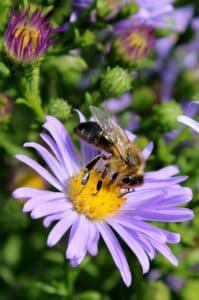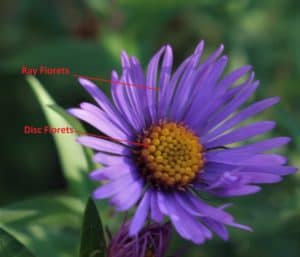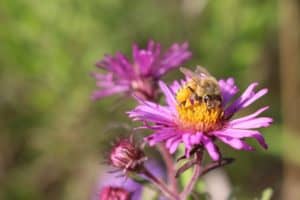
Throughout much of the northern parts of the country, the spring and summer landscape is predominantly green with splashes of color provided by a diversity of blooming flowers. As the season progresses the changing fall foliage dominates the autumn landscape with reds and golds but there is still one last floral splash of color that persist until frost in much of the country. Just as decreasing daylight and the changing of leaves indicate winter is approaching, the appearance of New England Aster bloom is a sure sign that the end of bee season is nearing.

New England Aster (Symphyotrichum novae-angliae) is a member of the aster family (Asteraceae) which is a large and diverse family including edibles like lettuce, artichokes, and sunflowers as well as popular ornamentals like dahlias, zinnias, and marigolds. One of the defining characteristics of the Asteraceae family is that they have composite flowers with the family also referred to as Compositae. The perimeter of aster flowers that appear to be petals are actually sterile ‘ray florets’. The central circle is composed of a collection of fertile “disc florets”. The flower of New England Aster is composed of ray florets that range from bright pink to purple or lavender surrounding an array of yellow or orange disc florets(see picture). It is an herbaceous perennial native to most of the eastern United States that prefers somewhat moist soils and full sun, and it is very common in fields and along roadside margins, particularly in ditches that hold moisture. Its tendency to freely grow wild in marginal habitats lead many to consider it a weed, but gardeners are increasingly incorporating it into the cultivated landscape as the awareness of native, pollinator-friendly species grows.

As a late-season source of both pollen and nectar, asters provide the last opportunity to for many colonies to forage. If you are out in the bee yard performing late season inspections or feeding and notice a forager bringing home pollen, there’s a good chance it has been working asters. The pollen is golden in color (see picture). In addition to honey bees, aster pollen serves as an important late season food source for a variety of bees, butterflies, and other pollinators including the next generation of bumble bee queens foraging prior to entering winter dormancy.
Reports vary on the importance and value of aster as a late season nectar source. Aster is not typically harvested as a monofloral honey variety but may contribute to fall goldenrod honey as there is an overlap in bloom periods. In American Honey Plants Frank Pellett notes this inclusion of aster with other fall nectar writing “Many reports are to the effect that the quality is poor and not suitable for table use. The fact that the honey is seldom unmixed with that of other fall flowers may be responsible for the impression.” Pellett also includes a report of the potential quality of pure aster honey should it be isolated “The honey was secured late in the season, after other plants has ceased to yield, and was almost white, and of very fine quality.”
Strong unpleasant smells, commonly described as similar to dirty socks or wet laundry, are noted by beekeepers when colonies are working aster, this may be partially attributed to coinciding goldenrod bloom which is known to give colonies a distinct sour smell when ripening the nectar. While the strong smell of the ripening nectar is not present to taint the cured honey there are some other potential implications of a late season aster flow. Regarding the concerns of aster honey as winter stores Pellett wrote “ . . .it is generally understood not to be safe for winter stores. Not only does aster honey contain gums which are indigestible to the bees, but the plants bloom so late that the honey may not be properly ripened.” Aster honey is also reported to readily granulate adding potential complications to the beekeeper if harvested and limiting accessibility to the bees if left for winter.